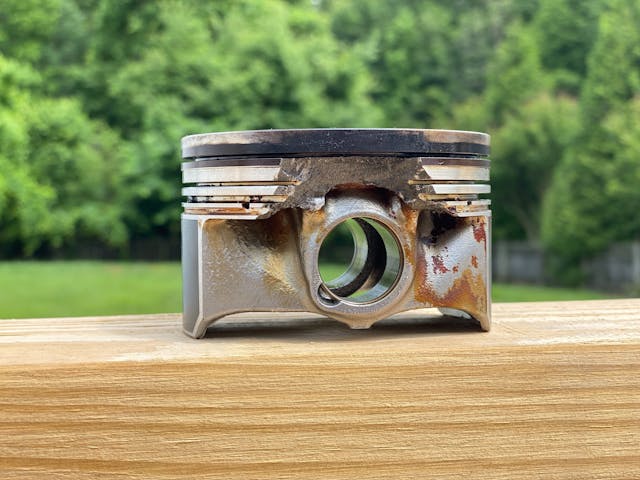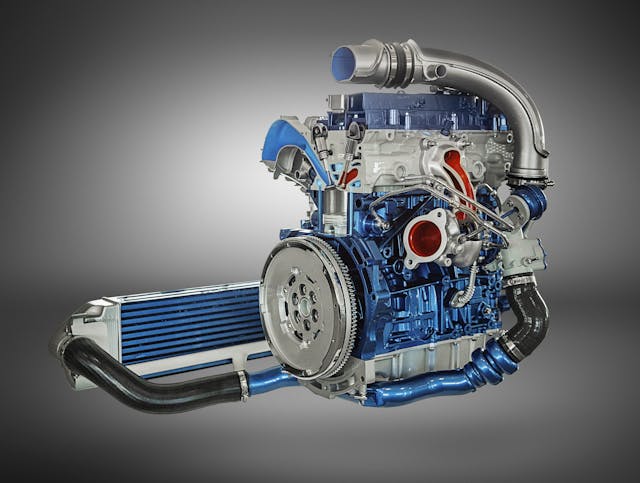How low-speed pre-ignition can damage your direct-injection turbo engine

Manufacturers are always chasing better efficiency goals. One of the more recent trends is to downsize engines and add turbocharging, as we see many six-cylinder engines being replaced by turbocharged four-cylinders in a variety of applications. The phenomenon has resulted in automakers’ mass adoption of supporting technologies, such as direct injection. Direct injection systems run under much higher pressures than traditional port injection systems, and turbocharging stresses the engine even further, so these engines have to be designed with safety in mind.
Even though modern engine computer programming mitigates the chance of overexerting the engine and causing damage, there are some unintended phenomena that can still pop up, albeit rarely. One is the irregular detonation effect, called low-speed pre-ignition (LSPI). LSPI can result in catastrophic engine damage under the right conditions. Conditions I witnessed first-hand when my brother’s Focus ST, which we had been doing some maintenance on, suddenly lost power and started burning oil.
We checked the car out and found that one of the cylinders had lost almost all compression. We decided to pull the engine and found that the ringland of one of the pistons had cracked, leading us to believe that there was some sort of knock in the engine that caused the failure. Explaining how that happened proved challenging, considering that the car was filled with 93-octane fuel (as Ford recommends) and previous ECU logs from showed no knock at all. After doing some digging, we came across the concept of LSPI, which seemed to account for our unfortunate situation. Not knowing much about LSPI, I decided reach out to an expert for more information on how my brother and I got so lucky.
LSPI and direct-injected, turbo engines
LSPI appears to be most common in small displacement turbocharged engines with direct-injection. The effect is classified as an abnormal combustion event and happens in a similar manner to traditional engine knock or detonation, in which a mixture is unintentionally ignited, and often not by a spark plug.

In a normal combustion scenario, fuel is sprayed into the cylinder and a spark plug is ignited to create the explosion that moves the piston and, in turn, moves the crankshaft. These operations are carefully timed in order to be synchronized and balanced. When an LSPI event occurs, however, this balance is interrupted and can result in catastrophic damage because of the random detonation.
We spoke to Michael Warholic, light duty lubricant Technology Manager at Valvoline, to find out more about the phenomenon and how worried vehicle owners should be. LSPI can be mitigated to some extent with the right engine oil formula. Warholic is a scientist who previously formulated such oils, and he has been involved with LSPI research and mitigation for almost a decade.
The issue of LSPI, Warholic notes, emerged as technologies like direct injection and turbocharging started to enter wide use in production vehicles. The industry responded in 2011, when manufacturers and suppliers came together to create a consortium to research the issue at Southwest Research Institute (SwRI) in Texas.
SwRI set up engines for monitoring and found that this type of knock is most prominent in situations with low speed and high load. The observation indicated high-pressure spikes and hot spots in the cylinders in such situations, and SwRI’s first hunch was that there were oil or fuel deposits on the cylinder walls that might be auto-igniting. After additional research, researchers found that there are spots in random areas of the cylinders that were getting hot enough to auto-ignite under the right combustion conditions, before the spark plug fired, causing this knock or detonation. Warholic described these spots of auto-ignition as “fireflies” because they would light up in the cylinder in various areas without a clear pattern.

Even though these events might be happening in an engine, Warholic says, they may not necessarily be catastrophic enough to cause engine damage—the catastrophic version of these events only happens under perfect conditions for LSPI. In that scenario, fuel or oil droplets are ignited, creating a high-pressure spike that can result in broken connecting rods, broken rings or ringlands, or even a cracked piston.
The secret is in the oil
Once researchers started digging into why these events were happening, they found that a detergent used commonly in engine oil, calcium sulfonate, was reactive to the conditions of LSPI. Testing reduced calcium sulfonate in engine, they noticed that LSPI events were significantly curbed. After these findings were verified, most oil companies and marketers decided to rebalance the detergents in their oils to reduce calcium sulfonate and replace it with magnesium sulfonate. This resulted in a new specification, called API SN Plus, that in 2018 required oil companies to reformulate their oils to be LSPI-friendly. The specification was based on a test created by Ford to measure LSPI events in EcoBoost engines.
There are other methods to reduce LSPI, such as increasing zinc or molybdenum content, but these are often found in racing oils. Street cars required measured usage of such ingredients, as zinc can poison catalytic converters and molybdenum can be corrosive. Manufacturers are testing various combinations of detergents and additives, but their conclusion has been that the oil chemistry can greatly impact LSPI events. All of the previous tests and research have been completed with fresh oil, and manufacturers are now developing tests to examine aged or used oil. Many believe that the effect can become worse as oil becomes older.

Traditional engine knock was pretty common in older engines, and it still happens in modern engines when combustion events happen early. The biggest difference with LSPI is the huge pressure spike. Direct-injection and turbocharging are the main culprits of increased pressure when LSPI-type knock happens. The engines used in testing and research have transducers mounted in the cylinders to monitor pressures, recording in-cylinder pressures that reach 1000 psi or more during LSPI events. Normal operation may show these pressures at half of that amount. Luckily, the events aren’t frequent, at least in testing as there may be 5 of these spikes over 100,000 engine cycles.
In addition to the changes in oil formulation, manufacturers can also make changes to their direct-injection systems to reduce chances of LSPI. Reducing pressures for direct-injection systems or richening up the fuel mixture is one approach, but OEMs try to avoid those changes given that doing so consume more fuel, thereby defeating the purpose of these systems in the first place.
Should you be worried about LSPI?
We asked Warholic if he would buy a small turbocharged and direct-injected engine, considering what he knows about the risks of LSPI. He said that he certainly would, but only while using the correct oil. (Fuel is not a risk factor for those in the United States, as fuel here is generally of high quality.) Warholic recommends a careful reading of the owner’s manual to find what API rating has been specified for the engine, and to make sure to only use that specification of oil to reduce the chances of LSPI damage. He believes that these new engines are incredibly efficient—he would not hesitate to buy one.
The specifications that owners of these engines might find in their manuals are SN Plus, SP, or GF6. SN Plus was the first interim solution to LSPI and an improvement over the SN standard. The detergents and additives in that specification are based on the earliest LSPI tests completed against a Ford EcoBoost engine. GF6, an improvement on SN Plus, is the latest and greatest specification from ILSAC when it comes to LSPI prevention. It includes all of the previous LSPI testing as well as a new chain wear test from Ford, better deposit requirements, and better fuel economy requirements. The GF6 specification was only released in the last month, so it may not be on the shelves yet, but Warholic expects that GF60-rated oils should be on the shelf sometime this summer. SP is the latest specification from API and mostly mirrors the GF6 specification.
Any of these three specifications should help to prevent LSPI, but SP and GF6 are the latest versions owners should look for when making a purchase to ensure that they are getting the best for their engine. According to Warholic, Valovline will spread the GF6 and SP specification to essentially its entire line. GF6 will be used for oils up to a 10W30 weight, as that is the maximum ILSAC grade, but API SP will be in use for their heavier oils. In short order, the rest of the industry is likely to follow the same path for oil formulation.
Small-displacement turbocharged engines are not going away, and direct-injection systems will likely become more advanced, so it’s important to prevent these issues before they, say, break your piston.

